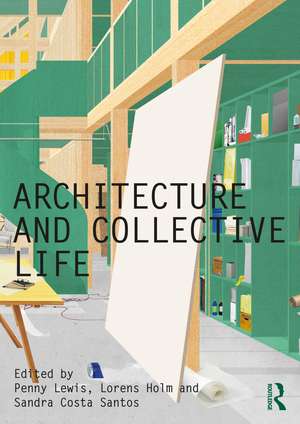Architecture and Collective Life: Critiques
Editat de Penny Lewis, Lorens Holm, Sandra Costa Santosen Limba Engleză Paperback – 29 oct 2021
Written by an international range of contributors, the chapters address the intersection of public life and the built environment around the themes of authority and planning, the welfare state, place and identity and autonomy. The book covers a diverse range of material from Foucault’s evolving thoughts on space to land-scraping leisure centres in inter-war Belgium. It unpacks concepts such as ‘community’ and ‘collectivity’ alongside themes of self-organisation and authorship.
Architecture and Collective Life reflects on urban and architectural practice and historical, political and social change. As such this book will be of great interest to students and academics in architecture and urbanism as well as practicing architects.
Din seria Critiques
- 8%
 Preț: 385.97 lei
Preț: 385.97 lei -
 Preț: 346.87 lei
Preț: 346.87 lei -
 Preț: 328.06 lei
Preț: 328.06 lei - 12%
 Preț: 328.00 lei
Preț: 328.00 lei - 12%
 Preț: 328.00 lei
Preț: 328.00 lei - 15%
 Preț: 433.19 lei
Preț: 433.19 lei - 26%
 Preț: 990.57 lei
Preț: 990.57 lei - 13%
 Preț: 324.41 lei
Preț: 324.41 lei - 28%
 Preț: 990.09 lei
Preț: 990.09 lei - 25%
 Preț: 993.87 lei
Preț: 993.87 lei -
 Preț: 474.19 lei
Preț: 474.19 lei - 12%
 Preț: 338.81 lei
Preț: 338.81 lei - 22%
 Preț: 325.22 lei
Preț: 325.22 lei -
 Preț: 475.16 lei
Preț: 475.16 lei - 25%
 Preț: 769.51 lei
Preț: 769.51 lei - 14%
 Preț: 314.33 lei
Preț: 314.33 lei - 15%
 Preț: 248.59 lei
Preț: 248.59 lei
Preț: 244.94 lei
Preț vechi: 290.78 lei
-16% Nou
Puncte Express: 367
Preț estimativ în valută:
46.88€ • 48.76$ • 38.70£
46.88€ • 48.76$ • 38.70£
Carte tipărită la comandă
Livrare economică 14-28 aprilie
Preluare comenzi: 021 569.72.76
Specificații
ISBN-13: 9780367633905
ISBN-10: 0367633906
Pagini: 346
Ilustrații: 208
Dimensiuni: 174 x 246 x 22 mm
Greutate: 0.64 kg
Ediția:1
Editura: Taylor & Francis
Colecția Routledge
Seria Critiques
Locul publicării:Oxford, United Kingdom
ISBN-10: 0367633906
Pagini: 346
Ilustrații: 208
Dimensiuni: 174 x 246 x 22 mm
Greutate: 0.64 kg
Ediția:1
Editura: Taylor & Francis
Colecția Routledge
Seria Critiques
Locul publicării:Oxford, United Kingdom
Public țintă
Postgraduate, Professional, and Undergraduate AdvancedNotă biografică
Penny Lewis is Programme Lead for the University of Dundee and Wuhan University Architectural Studies Programme, a job which involves teaching in China. From 1999 to 2007 she was editor of Prospect, the Scottish architecture magazine and a regular contributor to national papers and architectural journals. Her PhD on The impact of ecological thought on architectural theory from 1968 remains an ongoing research interest alongside work on the city.
Lorens Holm is Reader in Architecture and Director of the Geddes Institute for Urban Research at the University of Dundee, where he runs the design research unit rooms+cities. His written work focuses on reconciling Lacanian thought on subjectivity with contemporary architectural/urban practice. Publications include Brunelleschi Lacan Le Corbusier (2010) and, with John Hendrix, Architecture and the Unconscious (2016). His papers have appeared in Architecture and Culture, ARQ, Journal of Architecture, Perspecta, Critical Quarterly, Architecture Theory Review, and Assemblage.
Sandra Costa Santos is an architect and academic with research in the fields of architectural theory and architectural design with a particular interest in housing and the home. She is a Senior Lecturer in Architecture, Architecture and Urban Planning, School of Social Sciences, University of Dundee.
Lorens Holm is Reader in Architecture and Director of the Geddes Institute for Urban Research at the University of Dundee, where he runs the design research unit rooms+cities. His written work focuses on reconciling Lacanian thought on subjectivity with contemporary architectural/urban practice. Publications include Brunelleschi Lacan Le Corbusier (2010) and, with John Hendrix, Architecture and the Unconscious (2016). His papers have appeared in Architecture and Culture, ARQ, Journal of Architecture, Perspecta, Critical Quarterly, Architecture Theory Review, and Assemblage.
Sandra Costa Santos is an architect and academic with research in the fields of architectural theory and architectural design with a particular interest in housing and the home. She is a Senior Lecturer in Architecture, Architecture and Urban Planning, School of Social Sciences, University of Dundee.
Cuprins
Part I: Contradictions in a common world 1. Introduction 2. A tale of two villages: Jane Jacobs, Marshall McLuhan and their visions of collective life 3. Interview with Reinier de Graaf 4. Neofeudalism: The end of capitalism? 5. Alternative models of tenure: Recovering the radical proposal of collective housing Part II: New geography and the planners 6. A proprietary polis: Silicon Valley architecture and collective life 7. Hyper-gentrification and the urbanisation of suburbia 8. The dubious high street: Distinctiveness, gentrification and social value 9. Zero-institution culture Part III: Authority 10. Authorship and political will in Aldo Rossi’s theory of architecture 11. The heterotopias of Tafuri and Teyssot: Between language and discipline 12. Interruptions: A form of questionable fidelity Part IV: The welfare state 13. Constructed landscapes for collective recreation: Victor Bourgeois’s open-air projects in Belgium 14. Vienna’s Hofe: How housing builds the collective 15. Learning from Loutraki: Thermalism, hydrochemistry and the architectures of collective wellness 16. BiG: Living and working together Part V: Autonomy and organisation 17. Design precepts for autonomy: A case study of Kelvin Hall, Glasgow 18. Calcutta, India: Dover Lane – a cosmo-ecological collective life of Indian modernity 19. The city of ragpickers: Shaping a faithful collective life during les trente glorieuses 20. Visions of Ecotopia Part VI: Practice and life 21. Intraventions in flux: Towards a modal spatial practice that moves and cares 22. Ethics of open types 23. The Age of Ecology in the UK 24. Opinions – or, from dialogue to conversation 25. Epilogue The Wally Close Tenement: The collective close
Descriere
This book addresses the complex relationship between architecture and public life. It’s a study of architecture and urbanism as cultural activity that both reflects and gives shape to our social relations, public institutions and political processes.
